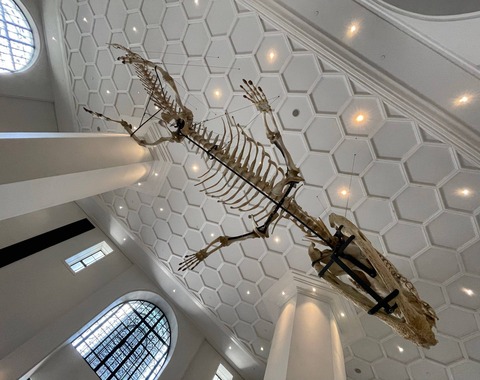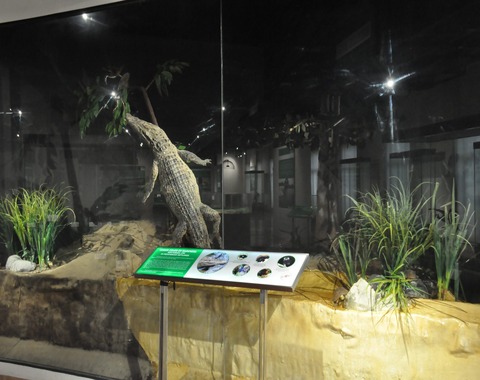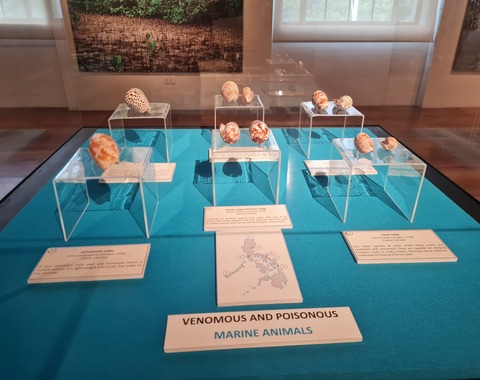National Musuem of Natural History

Ayala Reception Hall
Ayala Reception Hall
The Ayala Hall at the Philippine National Museum of Natural History features several notable exhibits. One exhibit showcases evidence of early human activity, including fossilized remains and stone tools from over 700,000 years ago in Kalinga Province. Additionally, the hall houses the Conus gloriamaris, a rare shell once believed to be one of the rarest in the world. Finally, visitors can see the hanging skeleton of "Lolong," formerly the largest saltwater crocodile in captivity, holding the Guinness World Record from September 3, 2011, to February 10, 2013.
READ MORE

Carabao Exhibit
Carabao Exhibit
This exhibit pays homage to the carabao, an iconic symbol of Philippine agriculture and rural life. Visitors can learn about the significance of the carabao in the country's cultural heritage, its importance as a working animal, and its role in sustaining agricultural practices.
READ MORE

Dinosaur Replica from the Gotuaco Collection
Dinosaur Replica from the Gotuaco Collection
The Philippine National Museum of Natural History received four exact replicas of dinosaur fossils, including the Tyrannosaurus rex, Ceratosaurus nasicornis, and Camarasaurus grandis, as part of the Larry and Pat Gotuaco Collection. These fossils provide visitors with an opportunity to learn about the Late Jurassic and Late Cretaceous periods, as well as the fascinating creatures that roamed the earth millions of years ago.
READ MORE

Freshwater Wetlands
Freshwater Wetlands
This exhibit highlights the importance of freshwater wetlands and their role in sustaining biodiversity. Visitors can learn about the diverse species that inhabit these ecosystems, including birds, fishes, and amphibians.
READ MORE

Mangroves, Beaches and Intertidal Zone
Mangroves, Beaches and Intertidal Zone
Delving into the coastal exhibit, visitors can explore the fascinating world of mangroves, beaches, and intertidal zones. Discover the ecological significance of mangrove forests, the unique adaptations of marine life in intertidal areas, and the importance of protecting these coastal ecosystems.
READ MORE
bg.jpg)
Hyundai Hall
Hyundai Hall
The Hyundai Philippines Entrance Hall serves as the primary entrance to the National Museum of Natural History. It has been meticulously restored to match the architectural drawings from 1939, capturing its grandeur and timeless design. Inside the entrance hall, visitors can marvel at the Marinduque Sperm Whale Skeleton, providing an intriguing sight to appreciate while awaiting admission to the museum.
READ MORE
bg.jpg)
Life Through Time
Life Through Time
Journeying through this exhibit, visitors can explore the evolution of life on Earth and the fossil record of the Philippines. From ancient marine creatures to the early mammals that roamed the archipelago, this exhibit provides insights into the rich evolutionary history of the region.
READ MORE
bg.jpg)
Martha Atienza
Martha Atienza
Martha Atienza is a renowned contemporary artist whose works often revolve around themes of identity, migration, and environmental concerns. Her exhibit within the museum provides a thought-provoking artistic perspective on these topics, combining visual art, video installations, and multimedia presentations. Through her creations, Atienza invites visitors to reflect on the complex relationship between humans and their environment.
READ MORE
bg.jpg)
Minerals and Energy Resources
Minerals and Energy Resources
This exhibit showcases the abundant mineral and energy resources found in the Philippines. Visitors can marvel at the diverse range of minerals, gemstones, and fossil fuels that contribute to the country's economic development and industrial growth.
READ MORE
bg.jpg)
Our Natural Inheritance
Our Natural Inheritance
The gallery at the National Museum of Natural History offers an immersive experience, starting with an audio-visual presentation on UNESCO World Heritage Sites in the Philippines. It provides an introduction to the country's protected areas and diverse biodiversity. In the adjacent room, visitors can explore a globe representing the Earth's biosphere and its climate system.
READ MORE
bg.jpg)
Petrified Wood From The Gotuaco Collection
Petrified Wood From The Gotuaco Collection
In 2018, the National Museum of the Philippines received a significant donation from Larry and Pat Gotuaco, consisting of petrified wood collections. The collections feature 88 foreign woods from various countries and eight large pieces from local sources. These woods exhibit remarkable preservation, displaying detailed structures and vibrant color patterns. This collection provides a fascinating insight into the beauty and diversity of petrified wood.
READ MORE
bg.jpg)
Philippine Biodiversity
Philippine Biodiversity
Immerse yourself in lush dioramas that depict various ecosystems, such as rainforests, coral reefs, and mangroves. Encounter life-sized replicas of endemic and endangered species, including the Philippine eagle, tamaraw, and tarsier. Gain a deeper understanding of the country's delicate ecosystems and the importance of conservation efforts.
READ MORE
bg.jpg)
Pioneering Naturalist in the Philippines
Pioneering Naturalist in the Philippines
The gallery at the National Museum of Natural History celebrates the birth of a naturalist, driven by a passion for knowledge and a desire to understand the complexities of the natural world. It showcases the impact of early voyages, which led to important discoveries that continue to be relevant. This collection highlights the historical and ongoing contributions of naturalists in unraveling the secrets of the natural environment.
READ MORE
bg.jpg)
The Geology of the Philippines
The Geology of the Philippines
Delve into the Earth's fascinating geological history in the Geological Gallery. From majestic rock formations to glittering minerals, this exhibit showcases the geological wonders of the Philippines. Learn about the country's volcanic origins, examine stunning mineral specimens, and gain insight into the geological processes that have shaped the Philippine archipelago.
READ MORE
bg.jpg)
The Marine Realm
The Marine Realm
Dive into the wonders of the Philippine seas in the Marine Realm exhibit. Explore vibrant coral reefs, encounter mesmerizing marine creatures, and learn about the importance of protecting marine ecosystems. Interactive displays offer a glimpse into the unique marine biodiversity of the Philippines, including its world-renowned dive sites and the ongoing conservation efforts to preserve these fragile habitats.
READ MORE
bg.jpg)
The Mossy, Montane, and Pine Forests of the Philippines
The Mossy, Montane, and Pine Forests of the Philippines
This exhibit showcases the unique ecosystems found in the highlands of the Philippines. Visitors can explore the enchanting mossy forests, montane forests, and pine forests that are home to a wealth of endemic plants, birds, and other wildlife.
READ MORE
bg.jpg)
Tropical Lowland Evergreen Rainforest
Tropical Lowland Evergreen Rainforest
Venturing into the exhibit on tropical lowland evergreen rainforests, visitors can experience the lushness and complexity of this critical ecosystem. From towering trees to exotic animals, the exhibit showcases the intricate web of life within these rainforests and underscores the urgent need for conservation in the face of deforestation and habitat loss.
READ MORE
bg.jpg)
Ultramafic and Limestone Karst Forests
Ultramafic and Limestone Karst Forests
This exhibit focuses on the distinct ecosystems of ultramafic and limestone karst forests, which host unique plant species and support diverse wildlife. Visitors can gain insights into the ecological significance of these specialized habitats.